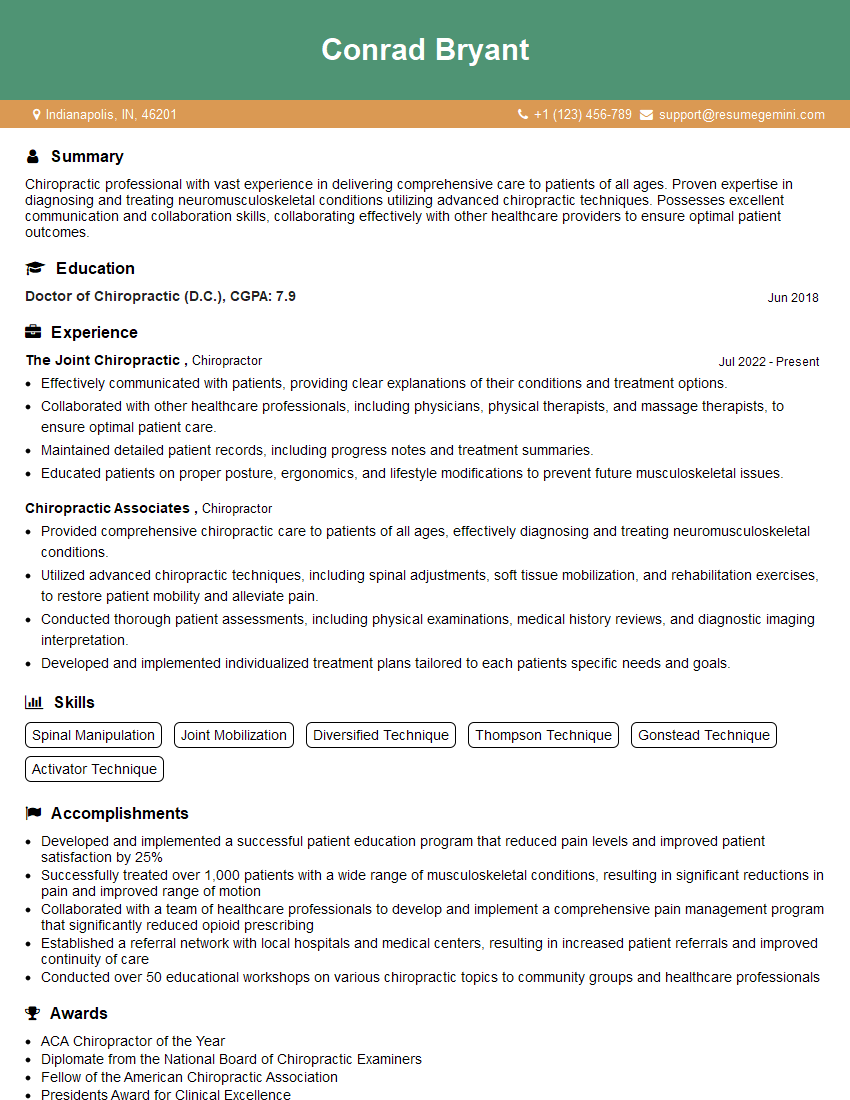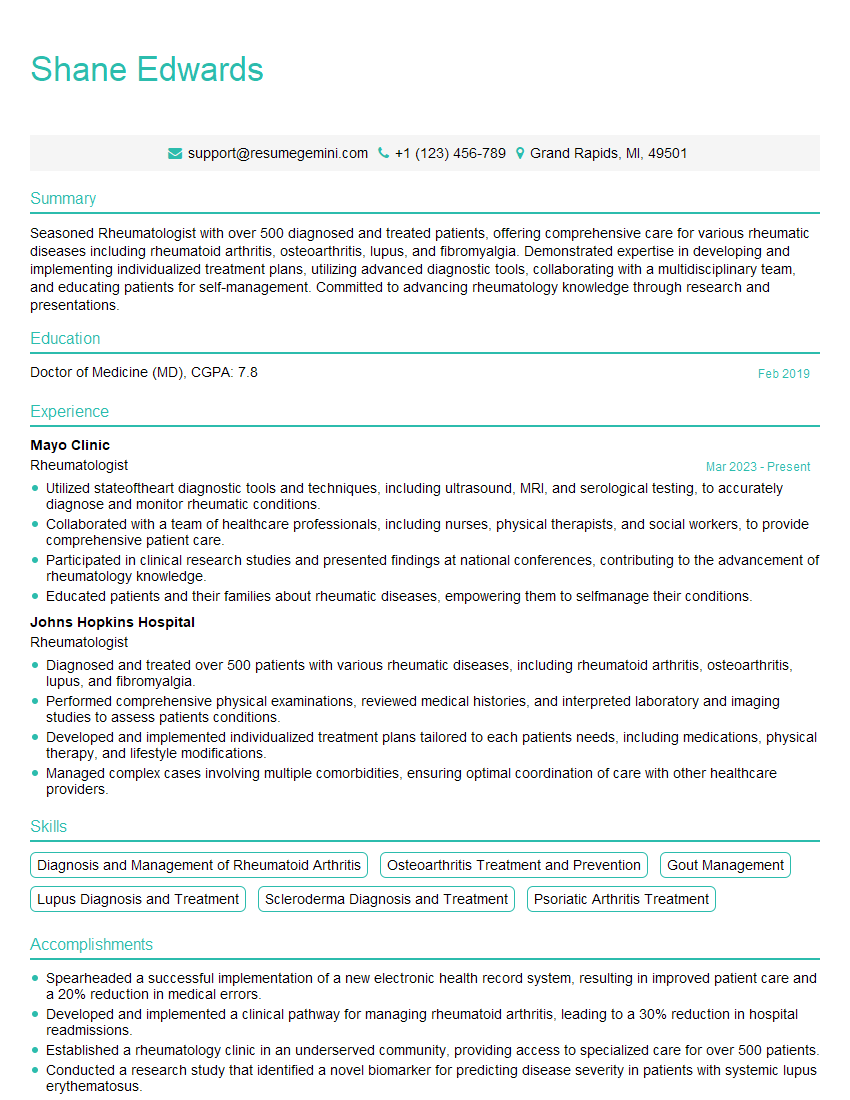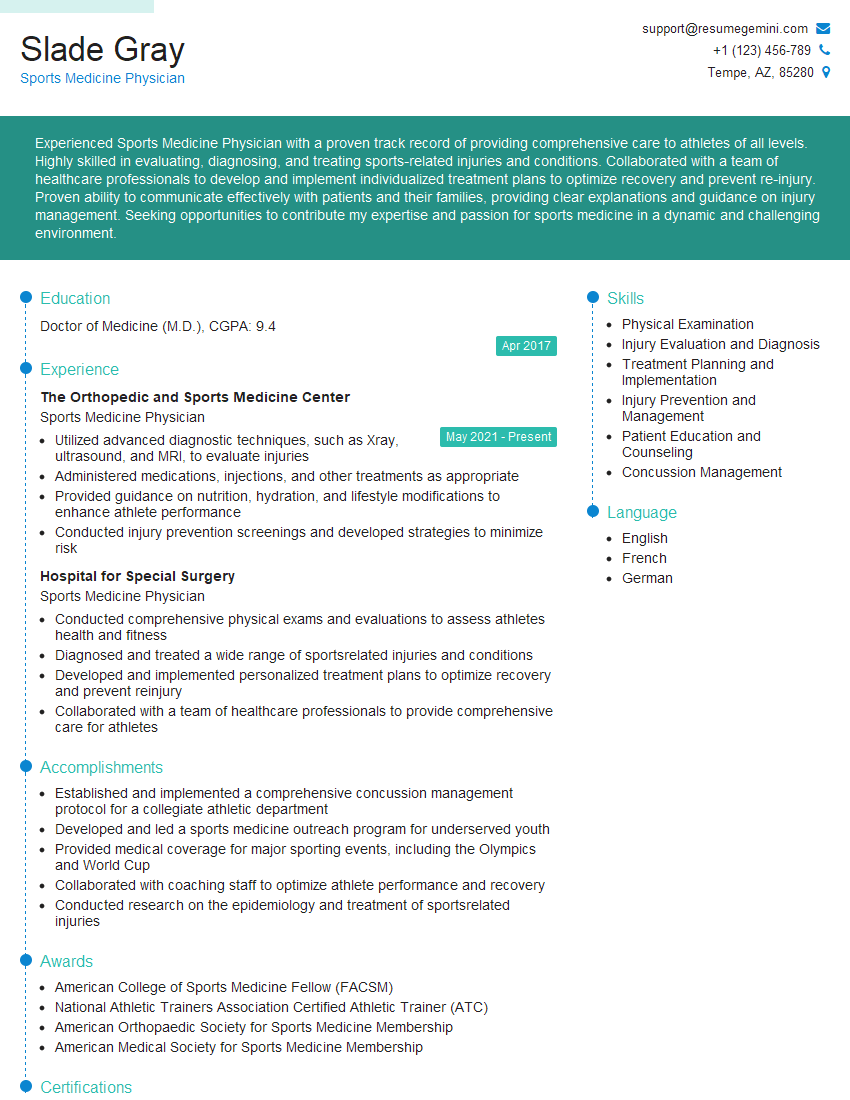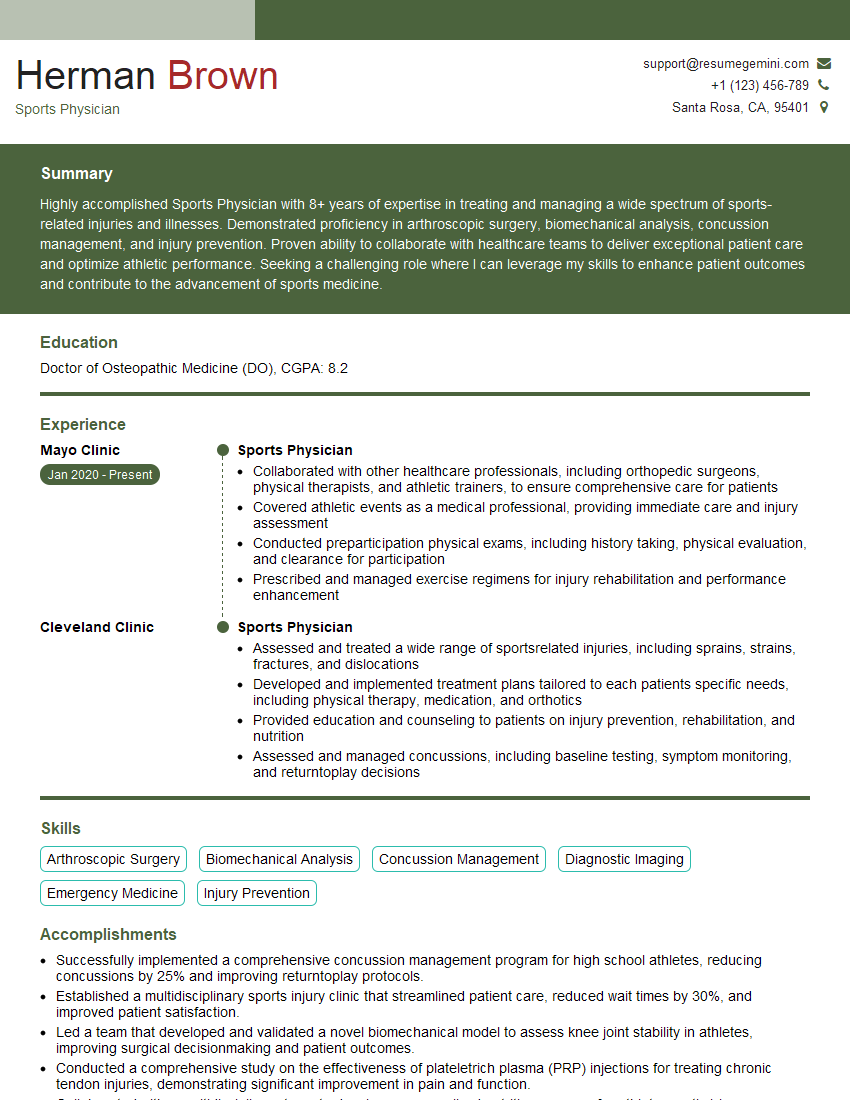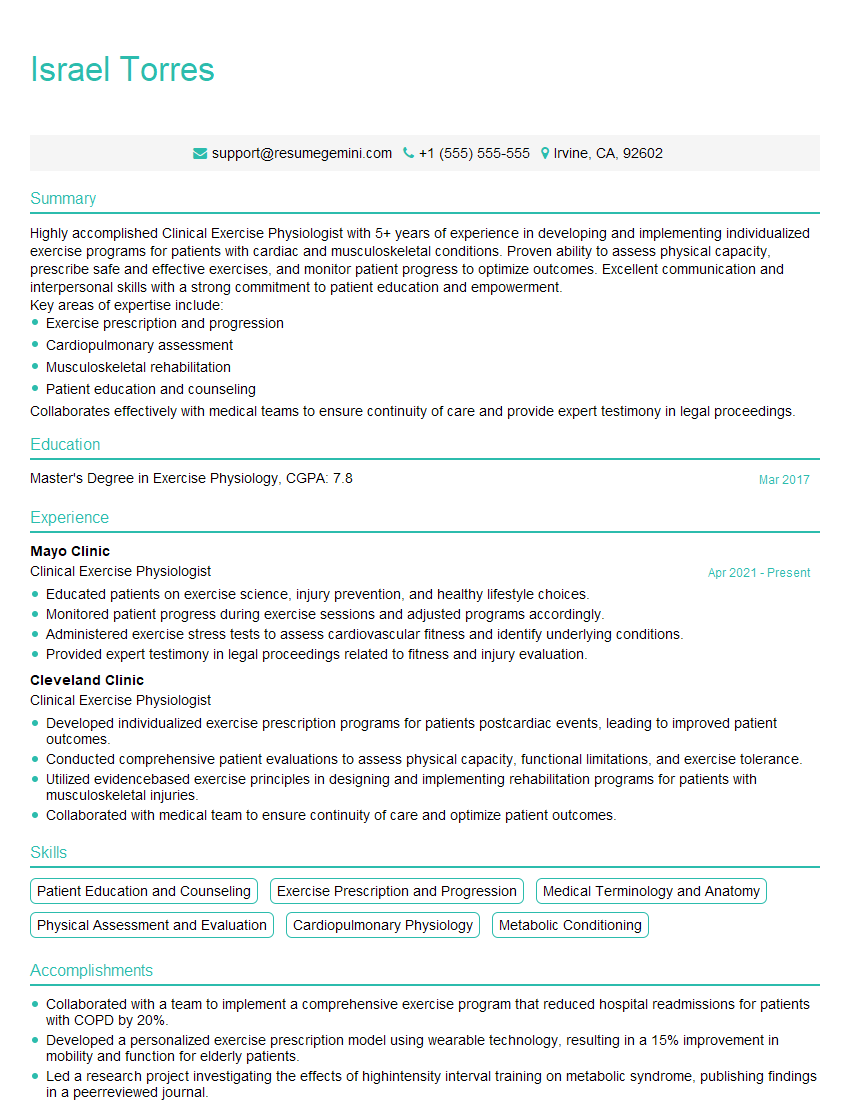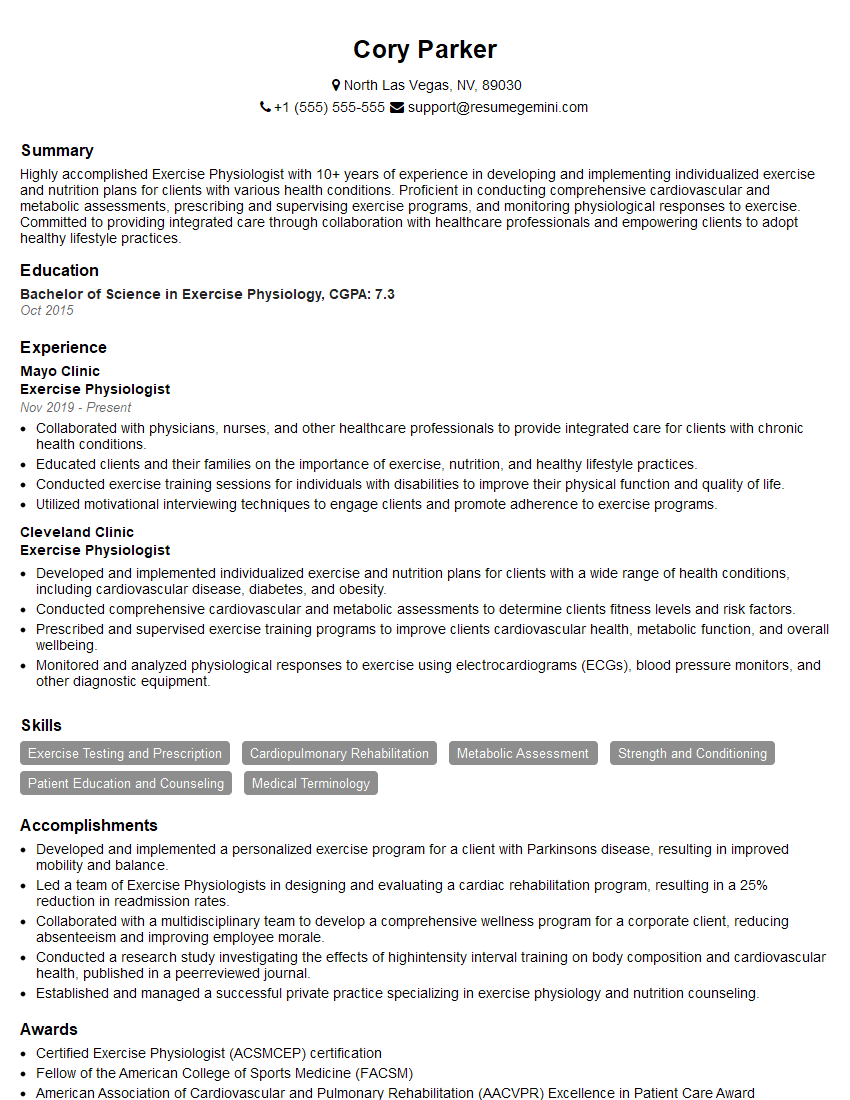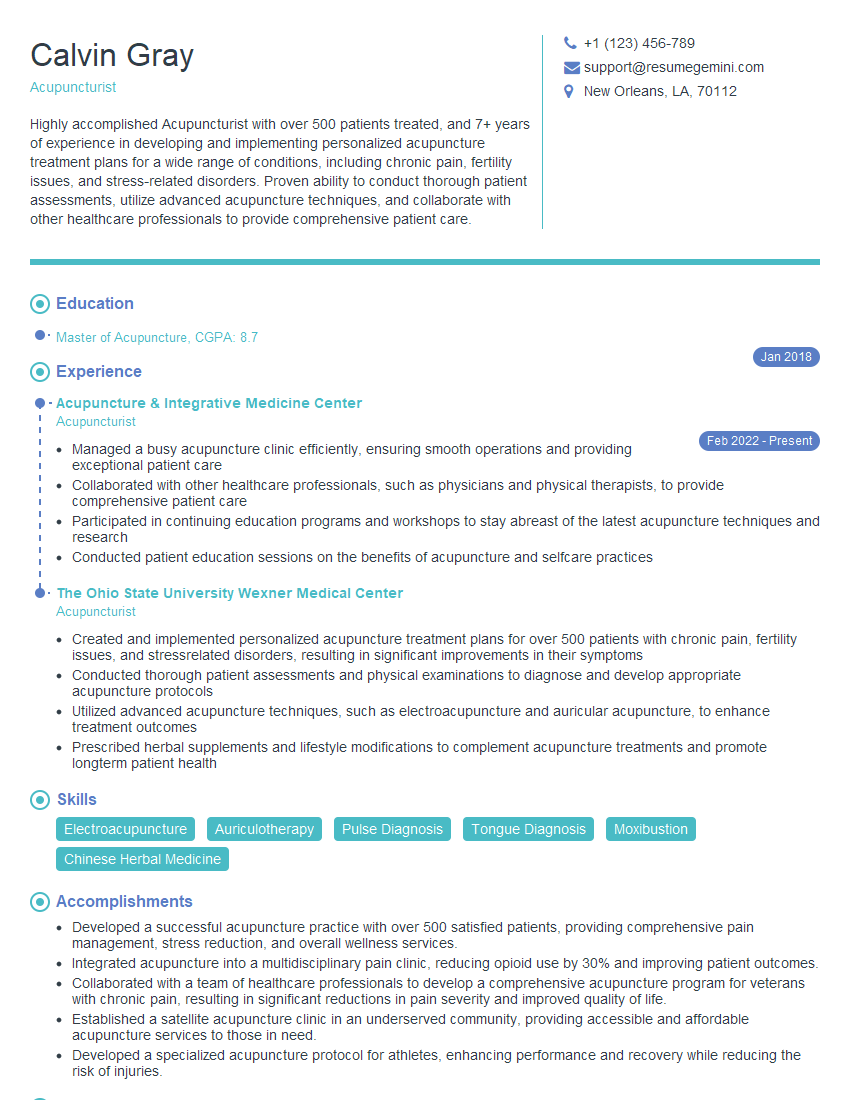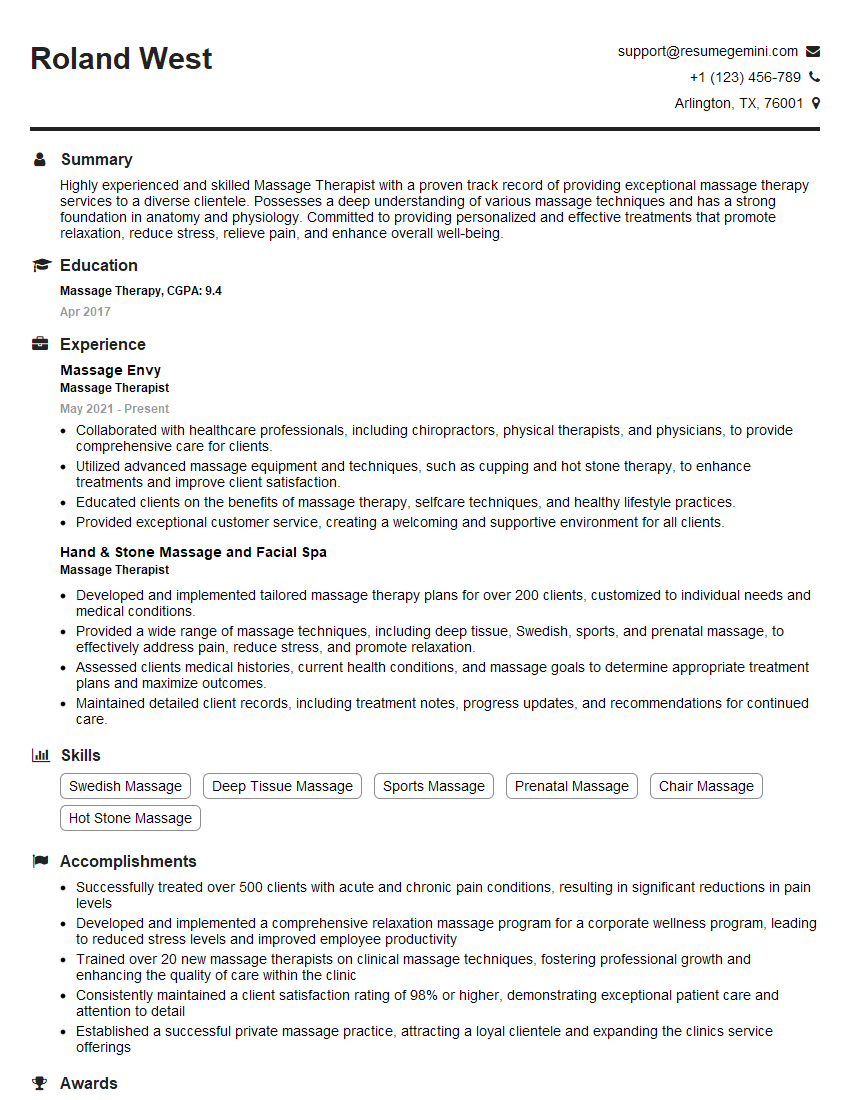Interviews are opportunities to demonstrate your expertise, and this guide is here to help you shine. Explore the essential Tendonitis Treatment interview questions that employers frequently ask, paired with strategies for crafting responses that set you apart from the competition.
Questions Asked in Tendonitis Treatment Interview
Q 1. Explain the pathophysiology of tendonitis.
Tendonitis, or tendinopathy, is an inflammatory condition affecting a tendon, the tough, fibrous cords connecting muscles to bones. Its pathophysiology is complex and not fully understood, but it generally involves a combination of factors. Think of a tendon like a strong rope; overuse, repetitive strain, or sudden trauma can cause microscopic tears and damage within the tendon’s collagen fibers. This damage triggers an inflammatory response, characterized by pain, swelling, and stiffness. The body attempts to repair the damage, but in chronic cases, this repair process can be inefficient, leading to further degeneration and potentially disorganized collagen formation. This is especially true in tendinosis, a degenerative condition with less inflammation compared to acute tendinitis. The process involves the release of inflammatory mediators like cytokines, prostaglandins, and matrix metalloproteinases, which contribute to the pain and tissue breakdown. This cascade of events can disrupt the tendon’s structure and function, causing it to become weak and vulnerable to further injury. Ultimately, the pathophysiology of tendonitis is a dynamic interplay between injury, inflammation, repair, and degeneration.
Q 2. Differentiate between tendinitis, tendinosis, and tenosynovitis.
While the terms are often used interchangeably, there are important distinctions between tendinitis, tendinosis, and tenosynovitis:
- Tendinitis: This refers to an acute inflammatory condition of a tendon, often characterized by significant pain, swelling, and redness. It’s typically caused by a sudden injury or overuse.
- Tendinosis: This describes a degenerative condition of the tendon characterized by collagen disorganization and breakdown, often without significant inflammation. It typically results from chronic overuse or repetitive strain and may be less painful initially but more prone to rupture.
- Tenosynovitis: This involves inflammation of the synovial sheath surrounding the tendon, often leading to pain, swelling, and crepitus (a crackling or grating sound during movement). It can be caused by injury, infection, or overuse.
Think of it this way: tendinitis is like a sudden sprain of the tendon, tendinosis is like the slow fraying of a rope, and tenosynovitis is like inflammation around the rope’s protective covering.
Q 3. Describe the diagnostic process for tendonitis, including imaging techniques.
Diagnosing tendonitis begins with a thorough history and physical examination. The physician will ask about the onset of symptoms, location and nature of pain, activities that aggravate or relieve the pain, and any previous injuries. A physical exam involves assessing range of motion, palpating for tenderness and swelling, and checking for any signs of instability. Imaging techniques are often used to confirm the diagnosis and rule out other conditions. These include:
- Ultrasound: This is often the first-line imaging technique. It can visualize tendon structure, assess for tears or inflammation, and is readily available and relatively inexpensive.
- MRI: Provides more detailed images than ultrasound, showing better visualization of the tendon and surrounding tissues. It’s useful for identifying subtle tears or assessing the extent of damage, but is more expensive and may not always be necessary.
In some cases, other tests like blood tests may be ordered to rule out systemic conditions. The diagnostic process emphasizes a combination of clinical findings and imaging to ensure accurate assessment.
Q 4. Outline the conservative treatment options for tendonitis.
Conservative treatment is the mainstay for most cases of tendonitis. The goals are to reduce pain and inflammation, improve tendon healing, and restore function. This typically involves:
- Rest and Modification of Activity: Avoiding activities that aggravate the condition is crucial. This may involve modifying work tasks, sports activities, or daily routines.
- Ice and Compression: Applying ice packs for 15-20 minutes several times a day can help reduce pain and inflammation. Compression can help to reduce swelling.
- Elevation: Elevating the affected limb can also help minimize swelling.
- Physical Therapy: A crucial component, physical therapy exercises focus on strengthening the surrounding muscles, improving range of motion, and correcting biomechanical issues that may contribute to tendonitis. This may include eccentric exercises (lengthening the muscle while contracting it), strengthening, and stretching.
- Non-steroidal anti-inflammatory drugs (NSAIDs): Over-the-counter or prescription NSAIDs can help manage pain and inflammation. (See Question 7 for a more detailed discussion on NSAIDs)
It’s important to emphasize that a tailored exercise program is essential and should be designed by a qualified physical therapist to prevent further injury and promote healing. The RICE (Rest, Ice, Compression, Elevation) principle is often used as a first-line treatment approach.
Q 5. What are the indications for surgical intervention in tendonitis?
Surgical intervention for tendonitis is generally reserved for cases that have not responded adequately to conservative treatment and where significant functional impairment persists. Indications for surgery may include:
- Complete Tendon Rupture: Surgery is often necessary to repair a completely torn tendon.
- Chronic Tendonitis with Significant Dysfunction: If conservative management fails to improve function after several months of diligent treatment, surgery might be considered.
- Failed Conservative Treatment: When other treatments haven’t provided relief and the patient continues to experience significant pain and disability.
- Presence of Internal Defects: Surgery may be indicated if imaging shows extensive internal tendon damage that doesn’t heal with conservative methods.
Surgical techniques vary depending on the specific tendon and the nature of the injury. They may involve debridement (removal of damaged tissue), tendon repair, or tendon reconstruction. Surgical intervention is a significant decision, requiring careful consideration of risks and benefits. A multidisciplinary approach, involving surgeons, physiotherapists, and other medical professionals is typically implemented.
Q 6. Describe the rehabilitation protocol post-tendonitis surgery.
Rehabilitation following tendonitis surgery is crucial for optimal recovery and preventing recurrence. It’s a phased approach typically involving:
- Early Postoperative Phase (weeks 1-6): Focuses on pain management, controlled range of motion exercises, and gradual weight-bearing as tolerated. This phase often involves minimizing stress on the injured tendon and limiting the range of movement.
- Intermediate Phase (weeks 6-12): This stage involves progressive strengthening exercises targeting the affected tendon and surrounding muscles. Therapists gradually increase the resistance and intensity of the exercises.
- Late Phase (weeks 12+): Emphasizes functional training and return to activity. This involves activities that simulate the patient’s daily routines and sporting activities. A progressive return to activity is essential, avoiding sudden increases in intensity or load to prevent re-injury.
The rehabilitation program should be tailored to the specific tendon, the extent of the surgical procedure, and the individual patient’s needs and progress. Close collaboration between the patient, surgeon, and physiotherapist is paramount throughout the rehabilitation process.
Q 7. Discuss the role of NSAIDs in tendonitis management.
NSAIDs, such as ibuprofen and naproxen, play a significant role in managing the pain and inflammation associated with tendonitis. They work by inhibiting the production of prostaglandins, chemicals that contribute to pain and inflammation. While they can provide temporary relief from pain and allow for improved mobility, it’s crucial to understand their limitations and potential side effects in the context of tendonitis management.
Benefits: NSAIDs can effectively reduce pain and inflammation in the acute phase of tendinitis. This can allow patients to participate in physical therapy exercises more comfortably.
Limitations: NSAIDs don’t address the underlying cause of tendonitis – the damaged tendon tissue. Long-term use can lead to gastrointestinal problems, increased risk of bleeding, and cardiovascular issues. Their effectiveness in long-term tendinosis management is less clear, as this condition is often characterized by less inflammation.
Clinical Application: NSAIDs are often used in the early stages of tendinitis to control pain and inflammation, allowing patients to begin physical therapy. However, long-term use should be carefully considered and balanced against potential side effects. In tendinosis, NSAIDs are generally less helpful, with a focus shifting toward physical therapy and other conservative methods.
Q 8. Explain the use of corticosteroid injections in tendonitis treatment.
Corticosteroid injections are sometimes used in tendonitis treatment to provide rapid pain relief and reduce inflammation. They’re essentially powerful anti-inflammatory drugs delivered directly to the affected tendon. Think of it like a targeted, localized dose of medication to quickly address the immediate problem.
How it works: Corticosteroids decrease the immune system’s response in the area, reducing swelling and pain. This can be beneficial for providing short-term relief, allowing for the initiation of physical therapy and other conservative treatments. However, it’s crucial to understand that this is not a long-term solution.
Important Considerations: While they can offer immediate pain relief, corticosteroid injections have potential drawbacks, including tendon rupture (weakening of the tendon), delayed healing, and local tissue atrophy. Therefore, they are usually reserved for cases of severe acute inflammation where other conservative treatments have not provided sufficient relief and are used judiciously in conjunction with a comprehensive rehabilitation program.
Real-world example: A patient with severe acute De Quervain’s tenosynovitis (inflammation of tendons in the thumb) experiencing debilitating pain might benefit from a single corticosteroid injection to manage pain and allow for improved participation in hand therapy.
Q 9. What are the potential complications of tendonitis?
Untreated or poorly managed tendonitis can lead to several complications. The severity varies depending on the location, severity, and duration of the inflammation. Some potential complications include:
- Chronic pain: Persistent pain that significantly impacts daily activities and quality of life.
- Tendon rupture: A complete tear of the tendon, often requiring surgery. This is more likely with repeated injections or in cases of severe degeneration.
- Tendon dysfunction: The tendon may not function properly, even after inflammation subsides, leading to weakness and limited range of motion.
- Bursitis: Inflammation of the bursa (fluid-filled sac) surrounding the tendon, adding to pain and discomfort.
- Muscle atrophy: Due to disuse or pain, the muscles surrounding the affected tendon may weaken and waste away.
- Limited range of motion: Stiffness and reduced flexibility in the affected joint.
Prevention is key: Early diagnosis and treatment, along with adhering to a proper rehabilitation program, significantly reduces the risk of these complications.
Q 10. How do you assess patient adherence to a tendonitis rehabilitation program?
Assessing patient adherence to a tendonitis rehabilitation program is crucial for successful treatment. It’s not just about asking; it requires a multifaceted approach. We utilize several methods to monitor and promote adherence:
- Regular appointments: Scheduled follow-up visits to monitor progress, assess pain levels, and review exercise technique.
- Self-reported questionnaires: Patients complete questionnaires detailing their exercise completion, pain levels, and any difficulties encountered.
- Activity logs: Patients record their daily activities, exercise sessions, and any pain experienced, offering a clear picture of their compliance.
- Objective measurements: Range of motion, strength tests, and functional assessments provide objective evidence of progress and adherence.
- Communication and feedback: Open communication channels encourage patients to voice concerns and receive tailored support.
- Goal setting: Setting realistic and achievable goals with the patient helps maintain motivation and promotes adherence.
Example: If a patient consistently misses exercises or reports difficulty, we modify the program, provide additional support, or explore potential barriers to compliance.
Q 11. Describe different types of tendonitis (e.g., rotator cuff, De Quervain’s).
Tendonitis can affect various tendons throughout the body. Here are some examples:
- Rotator cuff tendonitis: Inflammation of the tendons surrounding the shoulder joint, often causing pain and limited range of motion. This can affect any of the four rotator cuff muscles (supraspinatus, infraspinatus, teres minor, subscapularis).
- De Quervain’s tenosynovitis: This specific type affects the tendons that control the thumb’s movement, often causing pain at the base of the thumb and wrist. It’s often caused by repetitive hand movements.
- Achilles tendonitis: Inflammation of the Achilles tendon, the large tendon connecting the calf muscles to the heel bone. This frequently results from overuse or improper footwear.
- Patellar tendonitis (jumper’s knee): Inflammation of the tendon connecting the kneecap to the shinbone, commonly seen in athletes engaging in jumping activities.
- Epicondylitis (tennis or golfer’s elbow): Inflammation of the tendons on the outer (tennis elbow) or inner (golfer’s elbow) side of the elbow, usually caused by repetitive movements.
The symptoms and treatment may vary slightly depending on the specific tendon involved, but the underlying principles of rest, ice, compression, elevation (RICE), and rehabilitation remain largely consistent.
Q 12. How do you differentiate between tendonitis and other musculoskeletal conditions with similar symptoms?
Differentiating tendonitis from other musculoskeletal conditions requires a thorough examination and possibly additional diagnostic tests. Many conditions present with similar symptoms like pain, swelling, and limited range of motion.
Key distinguishing factors: The specific location of pain, the pattern of pain (e.g., worse with activity, at rest), the presence of specific physical findings (e.g., tenderness over the tendon, crepitus), and imaging studies (such as ultrasound or MRI) help to differentiate tendonitis from other issues such as:
- Bursitis: Inflammation of the bursa, often presenting similarly to tendonitis but with different pain localization.
- Ligament injuries: Ligaments connect bones, and injuries often involve instability and different patterns of pain compared to tendonitis.
- Fractures: Bone breaks are associated with sharp pain, swelling, and deformity.
- Arthritis: Joint inflammation with pain, stiffness, and decreased range of motion but different patterns of pain than localized tendonitis.
- Nerve compression: Can present with pain, numbness, tingling, and weakness, which differs from the typically localized pain of tendonitis.
A detailed medical history and physical exam combined with imaging techniques when necessary are crucial for accurate diagnosis.
Q 13. What are the common risk factors for developing tendonitis?
Several factors can increase the risk of developing tendonitis. These risk factors often interact, increasing the likelihood of injury. Understanding them is crucial for prevention.
- Repetitive movements: Repeatedly performing the same motion, such as typing, playing sports, or using power tools, puts excessive strain on tendons.
- Overuse: Engaging in strenuous activity without adequate rest or gradual progression can overload tendons.
- Poor posture: Incorrect body mechanics during activities can stress tendons.
- Improper technique: Poor form during exercise or work can place undue strain on tendons.
- Inadequate warm-up: Insufficient warm-up before activity leaves tendons vulnerable to injury.
- Age: As we age, tendons lose elasticity and become more susceptible to injury.
- Underlying medical conditions: Conditions such as diabetes and rheumatoid arthritis can increase the risk of tendonitis.
- Certain medications: Some medications can weaken tendons.
- Improper footwear: Inappropriate footwear can increase stress on tendons, particularly in the feet and ankles.
Lifestyle modifications: Addressing these risk factors through proper technique, gradual activity progression, adequate rest, and appropriate footwear can significantly reduce the chances of developing tendonitis.
Q 14. Explain the principles of eccentric exercise in tendonitis rehabilitation.
Eccentric exercise, where the muscle lengthens while contracting, plays a vital role in tendonitis rehabilitation. Unlike concentric exercise (muscle shortening), eccentric loading strengthens the tendon itself and improves its ability to withstand stress. It’s like strengthening the ‘springs’ of your tendons.
How it works: During eccentric exercise, the muscle fibers are stretched while generating force, stimulating collagen synthesis and improving tendon structure and function. Think of slowly lowering a weight during a bicep curl; that’s the eccentric phase.
Application: Eccentric exercises are often incorporated into rehabilitation programs for tendonitis. This is done gradually, starting with low loads and repetitions, and progressively increasing the intensity as tolerated. Examples include:
- Heel drops for Achilles tendonitis: Slowly lowering oneself onto the balls of the feet and then raising back up.
- Isometric exercises: Holding a muscle contraction for a period, slowly increasing the intensity.
- Lowering phase of bicep curls or calf raises: Focusing on the controlled lowering portion of the movement.
Important note: Eccentric exercise should be performed under the guidance of a physical therapist to prevent further injury and ensure proper technique. It is not always suitable for all stages of tendonitis, and the load should be manageable to avoid causing pain.
Q 15. Discuss the role of patient education in managing tendonitis.
Patient education is paramount in tendonitis management. It empowers individuals to actively participate in their recovery and prevents future occurrences. Think of it as providing the tools and knowledge for a successful DIY home repair project – you need to understand the problem and how to fix it to avoid further damage.
- Understanding the condition: Clearly explaining what tendonitis is, its causes (overuse, injury, repetitive movements), and its natural healing process is crucial. We need patients to understand that recovery takes time and patience.
- Activity modification: Educating patients on how to modify activities to reduce stress on the affected tendon is key. This involves teaching them proper body mechanics, identifying and avoiding aggravating activities, and gradual return to activity.
- Self-management techniques: This includes instruction on using RICE (Rest, Ice, Compression, Elevation), gentle stretching exercises, and the importance of adhering to prescribed physical therapy programs. We also discuss the appropriate use of over-the-counter pain relievers like ibuprofen or naproxen.
- Realistic expectations: Setting realistic expectations regarding the recovery timeline and potential limitations is vital. It’s about managing expectations and avoiding frustration when progress might be slow.
- Recognizing warning signs: Patients should know when to seek immediate medical attention, such as increased pain, swelling, or inability to use the affected limb.
Career Expert Tips:
- Ace those interviews! Prepare effectively by reviewing the Top 50 Most Common Interview Questions on ResumeGemini.
- Navigate your job search with confidence! Explore a wide range of Career Tips on ResumeGemini. Learn about common challenges and recommendations to overcome them.
- Craft the perfect resume! Master the Art of Resume Writing with ResumeGemini’s guide. Showcase your unique qualifications and achievements effectively.
- Don’t miss out on holiday savings! Build your dream resume with ResumeGemini’s ATS optimized templates.
Q 16. How do you modify activities to reduce stress on the affected tendon?
Modifying activities to reduce tendon stress involves a strategic approach focused on rest, avoidance, and gradual return to activity. Imagine your tendon as a strained muscle needing time to heal. We need to take the load off, then slowly reintroduce it.
- Rest and avoidance: Initially, complete rest from the aggravating activity is often necessary. For example, a tennis player with wrist tendonitis needs to completely avoid playing until the inflammation subsides.
- Modification of technique: For repetitive movements, we look for ways to alter the technique to reduce strain. Someone with golfer’s elbow might need to adjust their grip or swing.
- Gradual return to activity: Once the acute phase subsides, we gradually increase activity levels. This is a crucial step to prevent re-injury. We might start with short durations and low intensity, progressively increasing as tolerated.
- Alternative activities: We may suggest alternative, lower-impact activities that don’t stress the affected tendon. For example, a runner with Achilles tendonitis might switch to swimming or cycling temporarily.
- Ergonomic adjustments: We may recommend changes to workstation setup, tools used, or sporting equipment to optimize posture and reduce strain. A musician with tendonitis might need to adjust their instrument’s position.
Q 17. What are the common signs and symptoms of tendonitis?
Common signs and symptoms of tendonitis vary depending on the affected tendon, but generally include:
- Pain: This is usually the first symptom, often described as a dull ache that worsens with activity and improves with rest. It may also present as sharp pain in the tendon itself.
- Swelling: Inflammation causes swelling around the affected tendon. This is often noticeable to the touch.
- Stiffness: The affected joint may feel stiff and difficult to move, particularly in the morning or after periods of inactivity.
- Tenderness: The area over the tendon may be extremely tender to the touch.
- Crepitus: A crackling or popping sensation may be felt or heard when the tendon is moved.
- Weakness: Decreased strength or difficulty in performing actions that require the use of the affected tendon.
- Limited range of motion: Pain and stiffness can limit the ability to fully move the affected joint.
For example, De Quervain’s tenosynovitis, affecting tendons on the thumb side of the wrist, causes pain radiating down the thumb, particularly when gripping.
Q 18. Describe the process of assessing the severity of tendonitis.
Assessing tendonitis severity involves a combination of subjective and objective measures. Think of it like a layered approach to diagnosis – the more layers of information, the better understanding.
- Patient history: This includes details about the onset of symptoms, the nature of the pain, aggravating and relieving factors, and any relevant medical history. For example, the duration and intensity of the pain are crucial indicators.
- Physical examination: This involves a thorough assessment of the affected joint and tendon, including range of motion, palpation for tenderness and swelling, and testing muscle strength. We carefully examine the affected area for any signs of inflammation or deformity.
- Imaging studies: In some cases, imaging such as ultrasound or MRI may be necessary to visualize the tendon and confirm the diagnosis, rule out other conditions, and assess the extent of damage. Ultrasound is useful for visualizing tendon tears.
- Functional assessment: This evaluates the patient’s ability to perform activities of daily living and assesses any limitations caused by the tendonitis. For instance, we might ask the patient to perform specific tasks to see how they manage the pain.
Severity is often graded based on pain levels, functional limitations, and the presence of any tendon tears. This helps guide treatment decisions, determining the need for conservative or surgical management.
Q 19. Explain the use of ultrasound-guided injections in tendonitis treatment.
Ultrasound-guided injections are a minimally invasive procedure used to deliver medication directly to the affected tendon. It’s like using a GPS to target the treatment precisely. This improves the effectiveness and reduces potential side effects compared to blind injections.
- Improved accuracy: Ultrasound allows real-time visualization of the tendon and surrounding structures, ensuring accurate placement of the needle and minimizing the risk of injury to nearby nerves or blood vessels.
- Targeted delivery: This precise targeting improves the delivery of medication, leading to better pain relief and reduced inflammation.
- Reduced side effects: By precisely targeting the affected area, the risk of side effects such as nerve damage or bleeding is significantly reduced.
- Types of injections: Commonly used injections include corticosteroids (to reduce inflammation) and local anesthetics (to provide pain relief). We may combine these.
- Procedure details: The procedure is typically performed in a clinic setting using a sterile technique. The patient is often given local anesthesia to numb the area before the injection.
While effective for pain relief in the short term, it’s crucial to emphasize that corticosteroid injections are not a long-term solution and are often combined with physical therapy to address the underlying cause.
Q 20. What are the limitations of conservative treatment in tendonitis?
Conservative treatment, such as physical therapy, rest, and medication, is often the first line of defense against tendonitis. However, it does have limitations:
- Time-consuming: Recovery can take several weeks or even months, requiring patience and adherence to the treatment plan.
- Not effective for all cases: In some cases, particularly with severe tendon tears or chronic conditions unresponsive to conservative measures, surgery may be necessary.
- Potential for recurrence: If the underlying cause of tendonitis isn’t addressed, there’s a risk of recurrence even after successful conservative management.
- Limited pain relief: While conservative treatments can reduce pain and inflammation, they may not provide complete pain relief for all patients, especially those with severe conditions.
- Patient compliance: The success of conservative treatment relies heavily on patient adherence to the prescribed exercises, activity modifications, and medication regimen. Lack of compliance can significantly hinder the recovery process.
For instance, a patient with a significant rotator cuff tear might not respond fully to physical therapy alone and might require surgery to repair the tendon.
Q 21. How do you manage chronic tendonitis?
Managing chronic tendonitis requires a multi-faceted approach focusing on pain management, functional restoration, and prevention of recurrence. It’s like a long-term maintenance plan for a chronically strained machine.
- Comprehensive pain management: This might involve a combination of medications (NSAIDs, analgesics), modalities (ultrasound, iontophoresis), and injections. We may explore interventional pain management techniques if necessary.
- Graded exercise program: A carefully designed exercise program is vital to restore tendon strength, flexibility, and function. This program must be tailored to the individual and progressively increase the load on the tendon.
- Lifestyle modifications: Patients may need to make lasting changes to their lifestyle to minimize risk factors. This may involve improving ergonomics, reducing repetitive strain, and managing overall health.
- Address underlying conditions: Chronic tendonitis may be associated with other conditions, like arthritis or systemic illnesses. Treating these underlying conditions can significantly improve tendon health.
- Surgical intervention: In some cases, surgical intervention might be considered for chronic tendonitis that has not responded to conservative management, particularly if there is significant tendon damage. Surgery might involve debridement or repair of the damaged tendon.
It’s a marathon, not a sprint. Success requires commitment to the long-term plan, patience, and continuous monitoring to prevent further damage.
Q 22. Discuss the role of platelet-rich plasma (PRP) therapy in tendonitis.
Platelet-rich plasma (PRP) therapy is a regenerative medicine treatment that harnesses the body’s natural healing capabilities to treat tendonitis. It involves drawing a sample of the patient’s blood, processing it to concentrate platelets (which are rich in growth factors), and then injecting this PRP concentrate directly into the affected tendon. These growth factors stimulate the healing process, promoting tissue regeneration and reducing inflammation.
Think of it like giving the tendon a concentrated dose of its own natural healing power. The growth factors in PRP help to repair damaged tendon tissue, reducing pain and improving function. While not a guaranteed cure, PRP therapy has shown promising results, particularly in cases of chronic tendonitis that haven’t responded to other conservative treatments.
Q 23. What are the advantages and disadvantages of surgical treatment for tendonitis?
Surgical treatment for tendonitis is generally considered a last resort, reserved for cases that haven’t responded to conservative treatments such as physical therapy, medication, and injections. The advantages include the potential for complete repair of severely damaged tendons and quicker return to full function in some cases. However, surgery carries inherent risks, such as infection, scarring, nerve damage, and the need for a prolonged recovery period, often involving physical therapy.
- Advantages: Potential for complete repair, faster return to full function in select cases.
- Disadvantages: Risk of infection, scarring, nerve damage, prolonged recovery, potential for complications.
For example, a patient with a complete rotator cuff tear might benefit from surgery to repair the tear, but this decision is made after careful consideration of the risks and benefits alongside other treatment options. In many cases, conservative treatments are more successful and less invasive.
Q 24. How do you prevent tendonitis recurrence?
Preventing tendonitis recurrence is crucial for long-term well-being. This involves a multifaceted approach focusing on addressing the underlying cause of the tendonitis and modifying activities that contribute to its development. This includes:
- Proper Warm-up and Cool-down: Always warm up before any strenuous activity and cool down afterward to prepare and relax the muscles and tendons.
- Gradual Increase in Activity Levels: Avoid sudden increases in activity intensity or duration. Gradually increase the workload to allow the body to adapt.
- Correct Technique: Using proper technique for sports or work activities reduces strain on tendons.
- Strengthening and Stretching: Regular exercises to strengthen the muscles surrounding the affected tendon and improve flexibility are essential.
- Maintaining a Healthy Weight: Excess weight puts extra stress on joints and tendons.
- Addressing Underlying Medical Conditions: Conditions like rheumatoid arthritis can contribute to tendonitis. Managing these conditions is important.
For instance, a tennis player who experiences elbow tendonitis should focus on improving their serve technique, strengthening their forearm muscles, and gradually increasing their practice time. This preventative approach is far more effective than solely treating the pain.
Q 25. Describe the use of extracorporeal shock wave therapy (ESWT) in tendonitis.
Extracorporeal shock wave therapy (ESWT) is a non-invasive treatment that uses sound waves to stimulate healing in the affected tendon. The shock waves are delivered externally, penetrating the skin to reach the injured tissue. The mechanism isn’t fully understood, but it’s thought to promote tissue repair, reduce inflammation, and improve blood flow to the area. ESWT is often used for chronic cases of tendonitis that haven’t responded well to other conservative treatments.
It’s important to note that ESWT isn’t suitable for all types of tendonitis or all patients. It’s often used in conjunction with other therapies, such as physical therapy. The treatment usually involves a series of sessions over several weeks. Think of ESWT as a way to jumpstart the healing process by creating a controlled micro-trauma that stimulates the body’s natural repair mechanisms.
Q 26. What are the long-term implications of untreated tendonitis?
Untreated tendonitis can lead to several long-term implications, significantly impacting a person’s quality of life. These can include:
- Chronic Pain: Persistent pain that interferes with daily activities and sleep.
- Reduced Range of Motion: Limited ability to move the affected joint.
- Tendon Rupture: In severe cases, the tendon can tear completely, requiring surgical intervention.
- Functional Disability: Inability to perform work or recreational activities.
- Muscle Weakness and Atrophy: Due to decreased use of the affected limb.
For instance, untreated Achilles tendonitis could eventually lead to a complete rupture of the tendon, requiring extensive rehabilitation and surgery. Early intervention and treatment are crucial to prevent these long-term consequences.
Q 27. Describe your experience with managing tendonitis in specific populations (e.g., athletes, elderly patients).
Managing tendonitis in different populations requires a tailored approach. Athletes often require a more aggressive rehabilitation program to facilitate a quicker return to their sport, while elderly patients may require modifications to accommodate age-related factors and comorbidities. For athletes, I focus on functional rehabilitation, incorporating specific exercises that mimic the demands of their sport. With elderly patients, I prioritize pain management, safety, and functional improvements that enhance their daily activities, perhaps adapting exercises for better comfort and avoiding high-impact movements.
For example, a marathon runner with patellar tendonitis would need a specific strengthening and stretching program that focuses on the quadriceps and patellar tendons, while an elderly patient with the same condition might benefit from low-impact exercises and pain management strategies. Understanding the unique needs of each population is essential for effective treatment.
Q 28. How do you stay current with the latest research and best practices in tendonitis treatment?
Staying current with the latest research and best practices in tendonitis treatment is critical. I accomplish this through:
- Regular Review of Peer-Reviewed Journals: I actively read publications in journals like the American Journal of Sports Medicine and The Journal of Bone and Joint Surgery.
- Attendance at Medical Conferences and Workshops: Participation in continuing medical education activities keeps my knowledge up-to-date.
- Collaboration with Colleagues: Discussion and exchange of information with other healthcare professionals in my field is invaluable.
- Online Resources: Staying informed about updated guidelines and treatment protocols through reputable online medical resources.
By actively engaging in these activities, I ensure that my treatment approaches are evidence-based and aligned with the latest advancements in the field.
Key Topics to Learn for Tendonitis Treatment Interview
- Anatomy and Physiology of Tendons: Understanding tendon structure, function, and the biomechanics involved in tendon injuries is crucial. This includes knowledge of different tendon types and their susceptibility to injury.
- Pathophysiology of Tendonitis: Mastering the mechanisms of tendon injury, including inflammation, degeneration, and the role of various contributing factors (e.g., overuse, repetitive strain, age).
- Diagnosis and Assessment: Familiarize yourself with different diagnostic methods used to evaluate tendonitis, such as physical examination, imaging techniques (ultrasound, MRI), and laboratory tests.
- Conservative Treatment Modalities: Understand the various non-surgical treatment approaches, including rest, ice, compression, elevation (RICE), physiotherapy, medication (NSAIDs, corticosteroids), and bracing/splinting. Be prepared to discuss their indications, contraindications, and effectiveness.
- Surgical Treatment Options: Become proficient in the various surgical techniques employed in severe cases of tendonitis, such as tenotomy, tenodesis, and tendon repair. Understand post-operative management and rehabilitation protocols.
- Rehabilitation and Recovery: Understand the importance of a structured rehabilitation program in regaining function and preventing recurrence. This includes knowledge of exercises, modalities, and patient education strategies.
- Differential Diagnosis: Be prepared to discuss conditions that mimic tendonitis and how to differentiate them through thorough examination and investigation.
- Practical Case Studies: Review case studies of various tendonitis presentations, focusing on diagnostic reasoning, treatment planning, and outcome assessment.
- Current Research and Trends: Staying updated on the latest research in tendonitis treatment, including new therapeutic modalities and technological advancements.
Next Steps
Mastering Tendonitis Treatment demonstrates a deep understanding of musculoskeletal health and significantly enhances your career prospects in physiotherapy, sports medicine, orthopedics, and related fields. To maximize your job search success, creating a strong, ATS-friendly resume is essential. ResumeGemini is a trusted resource to help you build a professional and impactful resume that highlights your skills and experience. Examples of resumes tailored to Tendonitis Treatment are available to guide you.
Explore more articles
Users Rating of Our Blogs
Share Your Experience
We value your feedback! Please rate our content and share your thoughts (optional).
What Readers Say About Our Blog
This was kind of a unique content I found around the specialized skills. Very helpful questions and good detailed answers.
Very Helpful blog, thank you Interviewgemini team.



